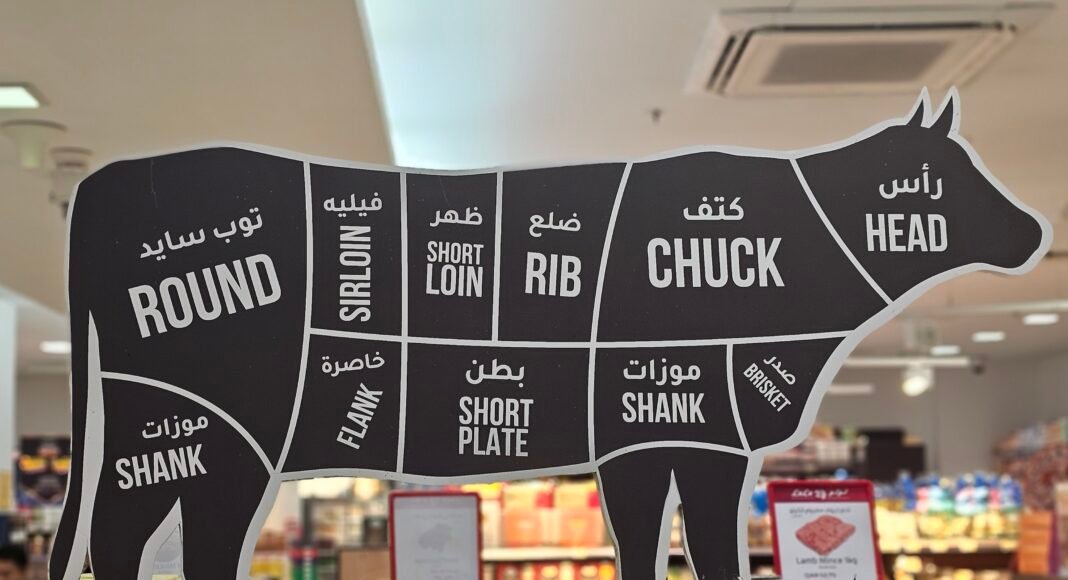Beef Cuts And Popular Steak Types
Working in the hotel industry, especially in 5-star hotels, requires well-trained and professional staff. These staff need to have all the required knowledge in the specific department. In this particular case, when it comes to different types of beef cuts, all the staff working in the food and beverages department must have the proper training and resources to identify all the types of beef cuts as guests often have questions about the menu. If a waiter knows the types of beef cuts and steak types, they can explain and recommend dishes better.
Different types of beef cuts have different flavors and textures. Knowing these helps the restaurant staff describe what the steak will taste like, which helps guests choose what they want to eat. U should know also that some steaks go well with certain sides or drinks. If waiters know their steaks, they can make better suggestions for a complete meal. When waiters know their stuff, they seem more confident and trustworthy. This makes the dining experience better for guests.
Types Of Beef Cuts
Now that we know why is important to know about the different types of beef cuts, let’s scroll down and have a look into all the beef cuts and their part in the buddy.

- Ribeye
Ribeye steak is one of the most popular types of beef cuts. It’s known for its rich flavor and tenderness. The ribeye is cut from the cow’s rib section, specifically the sixth through the twelfth ribs. It includes the longissimus dorsi muscle, which is well-marbled with fat, contributing to its tenderness and flavor. Some of the types of the ribeye cuts includes: Bone-In Ribeye (Cowboy Steak), Boneless Ribeye, Tomahawk Steak, Spinalis Dorsi (Ribeye Cap) and more. Best cooking methods for a Ribeye steak are grilling, pan-searing, or broiling. - Tenderloin (Filet Mignon)
Tenderloin is another type of beef cuts and a popular steak type which is often referred to as filet mignon when cut into smaller portions, is prized for its exceptional tenderness and mild flavor. The tenderloin is a long, cylindrical muscle located along the spine of the cow, running from the short loin to the sirloin. It is comprised of the psoas major muscle, which does very little work, resulting in its characteristic tenderness. Some of the types of the tenderloin cuts includes: Filet Mignon, Chateaubriand, Tournedos and Medallions. Best cooking methods for a tenderloin steak are grilling, pan-searing, or roasting (same as Ribeye). - New York Strip (Striploin)
From types of beef cutes we do have as well the New Work Strip. The New York Strip, also known as the striploin, is a popular cut of steak known for its robust flavor and fine texture. The name “New York Strip” is believed to have originated from Delmonico’s, a famous New York City restaurant that popularized the cut. This part is a cut from the short loin of the cow, specifically from the longissimus dorsi muscle, which runs along the back of the animal. Some of the types of the striploin cuts includes: Bone-In New York Strip, Boneless New York Strip and Kansas City Strip. For the cooking methods is the same as Ribeye and Tenderloin (grilled, pan-seared, roasted). - T-Bone
The T-bone steak is a popular and iconic cut of beef known for its distinctive T-shaped bone, which separates two different cuts of meat. The T-bone steak is cut from two different cuts of meat: the striploin (or New York Strip that we mentioned above) on one side of the bone and a smaller portion of the tenderloin (or filet mignon) on the other. Standard T-Bone is the first type of cut of this part and Porterhouse which is a larger version of the T-bone, with a more substantial portion of the tenderloin. According to the USDA, a porterhouse must have at least 1.25 inches of tenderloin muscle across its widest point, while a T-bone must have at least 0.5 inches. Best cooking methods for a T-Bone steak are grilling, broiling, pan-searing and reverse searing. - Sirloin
Sirloin steak is a versatile and popular cut of beef known for its balance of flavor, tenderness, and affordability. The sirloin is located in the hindquarter of the cow, between the short loin and the round. This particular section include several muscles, leading to a variety of cuts with different characteristics in terms of tenderness and flavor. Some of the types of the Sirloin cuts includes: Top Sirloin, Bottom Sirloin and Sirloin Tip. Sirloin steaks are a favorite for their versatility, affordability, and robust flavor. They are well-suited to a variety of cooking methods and make a great choice for both everyday meals and special occasions. Best cooking methods for a Sirloin steak are grilling, broiling, pan-searing and reverse searing. - Flank
Flank steak is a flavorful and relatively lean cut of beef that is known for its versatility and affordability. Flank is a cut from the abdominal muscles or lower chest of the cow, specifically from the flank primal, located behind the plate and beneath the loin. Flank steak has a distinctive, coarse texture with long muscle fibers, making it a bit chewier than more tender cuts. Best cooking methods for a Flank steak are, marinating and grilling or boiling. - Plate
The cow has 13 bones in the ribs and backbones – the last 6 is in the above section under “Ribs”, the plate is the first 7 ribs. They are flavorful but not quite as expensive, and tend to be a little tougher cut of meat. From this cut there are many types of meat such as short ribs, ground beef, skirt steak, bacon, pastrami. The beef plate is a thin, inexpensive, and easy-to-cook piece of meat. The beef plate is a good choice for braising or making ground beef. - Brisket
Brisket is a flavorful and versatile cut of beef that comes from the chest or breast section of the cow. It is known for its rich flavor and the need for slow cooking to achieve tenderness. Brisket is located beneath the first five ribs of the cow, extending towards the belly, encompassing the pectoral muscles. Brisket consists of two main muscles: the point (also known as the deckle) and the flat. The point is fattier and more marbled, while the flat is leaner and broader. Brisket’s rich flavor and versatility make it a beloved choice for various culinary traditions, from BBQ to braising. Its ability to transform with slow cooking methods into a tender, flavorful dish makes it a staple for gatherings and special occasions. - Chuck
Chuck is another cut of the beef part which comes from the shoulder and neck area of the cow, extending down to the fifth rib. It includes a variety of muscles that work hard, which contributes to its flavor but also requires longer cooking times to tenderize. You must know that chuck is a tough cut of meat due to its high connective tissue content and muscle use. Proper cooking methods, such as braising or slow cooking, break down this tissue, resulting in tender meat. Some of the types of the chuck cuts includes: Chuck Roast, Chuck Steak and Chuck Short Ribs. Check is one the best options to be cooked in different kind of stews instead of steaks due to it’s tenderness as needs time to cooked properly. - Round
The round is a primal cut of beef that comes from the hind leg of the cow. It is known for being lean and less tender compared to cuts from the loin or rib sections. The round is located in the rear leg of the cow, extending from the rump to the leg joint and consists of multiple muscles, including the top round, bottom round, eye of round, and sirloin tip (though the sirloin tip is sometimes considered part of the sirloin rather than the round). The Round Beef Cut is inexpensive and tough and is often used for hamburger. Best cooking methods for a round cut of beef are roasting, braising, steaks and thin slices. - Rump
The rump is located at the rear of the cow, behind the loin and sirloin sections. The rump consists of several muscles, including the top sirloin, bottom sirloin, and tri-tip (which is sometimes considered part of the sirloin rather than the rump). Rump cuts are lean and dense with a coarse texture. They are less tender compared to cuts from the loin or rib sections due to the well-exercised muscles. Some of the types of the Rump cuts includes: Top Sirloin, Bottom Sirloin and Tri-Tip. Best cooking methods for a Rump cut of beef are roasting, grilling, braising and slicing. - Shank
The shank is a cut of beef that comes from the lower portion of the leg of the cow. It is known for its tough texture and collagen-rich connective tissues, which require slow cooking methods to break down and tenderize. The shank consists of tough muscles that are well-exercised, resulting in a lot of connective tissue, collagen, and marrow. There are two types of Shank cuts, Fore Shank which is located closer to the front leg, it tends to be tougher and is often used in dishes like osso buco. The other part Hind Shank from the rear leg, it is slightly more tender than the fore shank and can also be used in slow-cooked dishes.
Now that you know all types of beef cuts and the most popular steak types, you should be more confident at the Restaurant you are working or eating.


